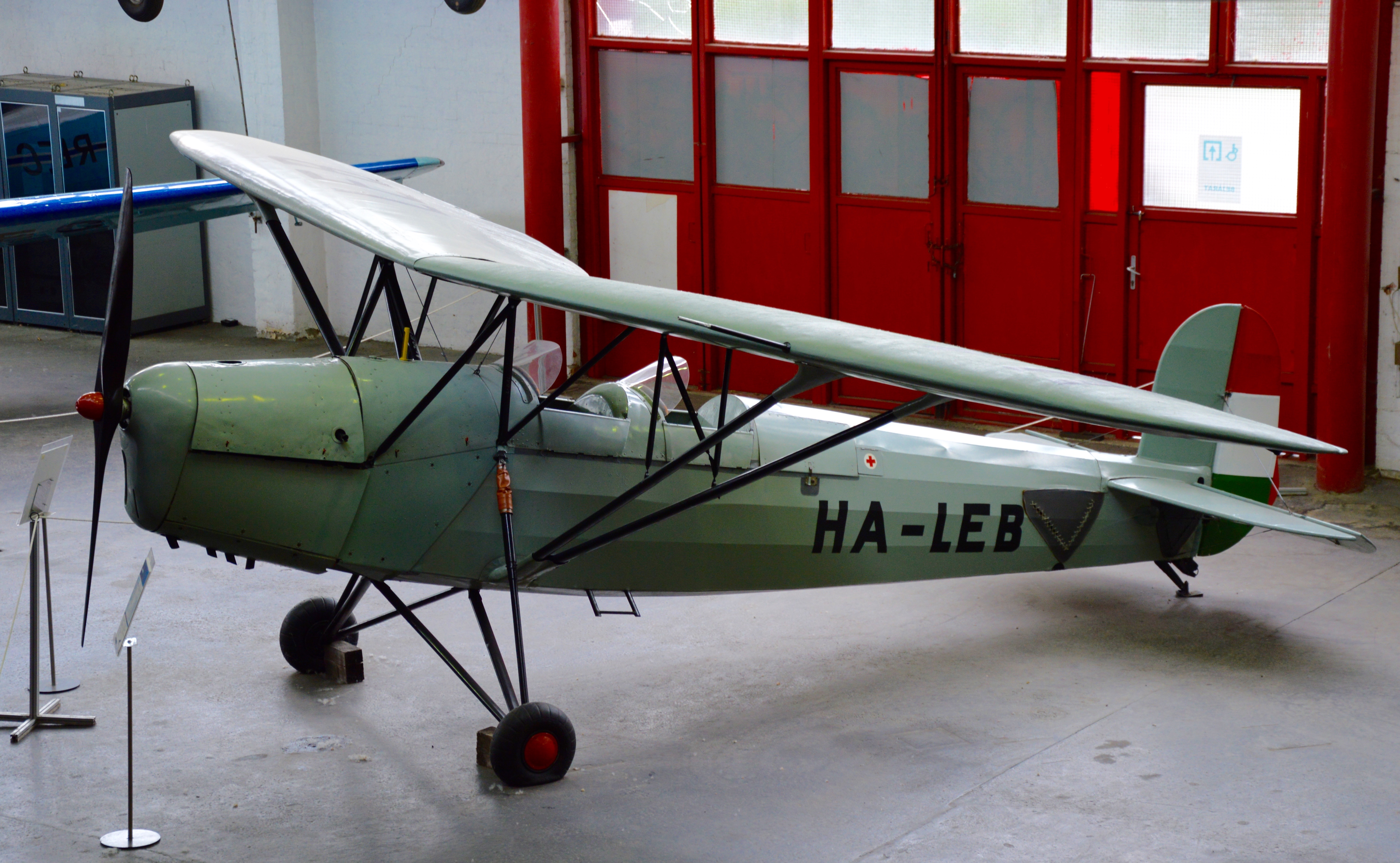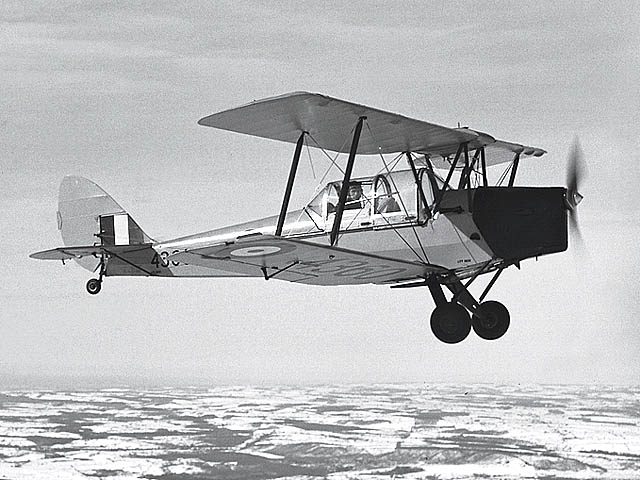|
Repülőgépgyár Levente II
The Repülőgépgyár Levente series is a Hungary, Hungarian two-seat trainer and liaison aircraft from World War II. Thanks to the simple, easy-to-repair design, despite the seemingly rudimentary appearance, the type was well suited to army co-operation and liaison tasks, and Levente IIs withstood damage well, thus they could survive the fire of contemporary aircraft such as the Lavochkin La-5 and Ilyushin Il-2. Design and development Two prototypes, designed by András Fábián, (Fábián András) were built in Rába (company), Magyar Waggon - és Gépgyár Rt. (Hungarian Wagon and Machine Factory; one of the few big corporations of the time) in Győr. However, a tender was placed by the air forces with the profile change of the MWG, and production rights were eventually granted to the Uhry brothers' factory (originally a small private vehicle body manufacturer, which later expanded rapidly and become a very successful competitor to elder corporations). The parasol-wing, open-co ... [...More Info...] [...Related Items...] OR: [Wikipedia] [Google] [Baidu] |
Közlekedési Múzeum
The Magyar Műszaki és Közlekedési Múzeum (; "Hungarian Technical and Transportation Museum"), still often referred to by its former name, Közlekedési Múzeum ("Transportation Museum"), is a museum in Budapest, Hungary. It is one of Europe's oldest transportation collections. The museum has a unique collection of locomotives and railway cars on a 1:5 scale. This means that a locomotive of, for example, 10 m length is reproduced with all details in a 2 m length model. The models represent a wide range of railway technology. The museum shows also a locomotive and wagon in real size with a railway station of the 1900s. Other parts of the museum are shown: * The history of road traffic: horse-drawn and machine-driven vehicles, road and bridge building with a collection of old cars, motorcycles, and bicycles. * The history of sailing. Sailing from the prehistoric ages, the history of Hungarian boat manufacturing is shown by models. * Deeper in the park there is a permanent exhi ... [...More Info...] [...Related Items...] OR: [Wikipedia] [Google] [Baidu] |
Royal Hungarian Air Force
The Hungarian Air Force (, ), is the air force branch of the Military of Hungary, Hungarian Defence Forces. The primary focus of the present Hungarian Air Force lies in defensive operations. The flying units operate are organised into a single command; under the Air Command and Control Centre. History 1918 to pre–World War II Following the dissolution of the Austro-Hungarian Monarchy in 1918, a small air arm was established operating surviving aircraft from Hungarian factories and training schools. This air arm became the Hungarian Red Air Force under the short-lived Hungarian Soviet Republic, but was disbanded upon its downfall. World War II Under the Treaty of Trianon (1920), Hungary was forbidden from owning military aircraft. However, a secret air arm was gradually established under the cover of civilian flying clubs. During 1938, as a result of the Bled agreement (1938), Bled agreement, the existence of the Royal Hungarian Air Force (), was made known. The army's a ... [...More Info...] [...Related Items...] OR: [Wikipedia] [Google] [Baidu] |
Aircraft First Flown In 1940
An aircraft ( aircraft) is a vehicle that is able to fly by gaining support from the air. It counters the force of gravity by using either static lift or the dynamic lift of an airfoil, or, in a few cases, direct downward thrust from its engines. Common examples of aircraft include airplanes, rotorcraft (including helicopters), airships (including blimps), gliders, paramotors, and hot air balloons. Part 1 (Definitions and Abbreviations) of Subchapter A of Chapter I of Title 14 of the U. S. Code of Federal Regulations states that aircraft "means a device that is used or intended to be used for flight in the air." The human activity that surrounds aircraft is called ''aviation''. The science of aviation, including designing and building aircraft, is called ''aeronautics.'' Crewed aircraft are flown by an onboard pilot, whereas unmanned aerial vehicles may be remotely controlled or self-controlled by onboard computers. Aircraft may be classified by different criteria, such ... [...More Info...] [...Related Items...] OR: [Wikipedia] [Google] [Baidu] |
Parasol-wing Aircraft
A monoplane is a fixed-wing aircraft configuration with a single mainplane, in contrast to a biplane or other types of multiplane (aeronautics), multiplanes, which have multiple wings. A monoplane has inherently the highest efficiency and lowest drag of any wing configuration and is the simplest to build. However, during the early years of flight, these advantages were offset by its greater weight and lower manoeuvrability, making it relatively rare until the 1930s. Since then, the monoplane has been the most common form for a fixed-wing aircraft. Characteristics Support and weight The inherent efficiency of the monoplane is best achieved in the cantilever wing, which carries all structural forces internally. However, to fly at practical speeds the wing must be made thin, which requires a heavy structure to make it strong and stiff enough. External Bracing (aeronautics), bracing can be used to improve structural efficiency, reducing weight and cost. For a wing of a given size, ... [...More Info...] [...Related Items...] OR: [Wikipedia] [Google] [Baidu] |
1940s Hungarian Military Utility Aircraft
Year 194 ( CXCIV) was a common year starting on Tuesday of the Julian calendar. At the time, it was known as the Year of the Consulship of Septimius and Septimius (or, less frequently, year 947 ''Ab urbe condita''). The denomination 194 for this year has been used since the early medieval period, when the Anno Domini calendar era became the prevalent method in Europe for naming years. Events By place Roman Empire * Decimus Clodius Septimius Albinus Caesar became a Roman Consul. * Battle of Issus: Septimius Severus marches with his army (12 legions) to Cilicia, and defeats Pescennius Niger, Roman governor of Syria. Pescennius retreats to Antioch, and is executed by Severus' troops. * Septimius Severus besieges Byzantium (194–196); the city walls suffer extensive damage. Asia * Battle of Yan Province: Warlords Cao Cao and Lü Bu fight for control over Yan Province; the battle lasts for over 100 days. * First year of the ''Xingping'' era during the Han Dynasty in C ... [...More Info...] [...Related Items...] OR: [Wikipedia] [Google] [Baidu] |
Polikarpov Po-2
The Polikarpov Po-2 (also U-2 before 1944, for its initial Glossary of Russian and USSR aviation acronyms: Aircraft designations, ''uchebnyy'', 'training', role as a flight instruction aircraft) was an all-weather multirole Soviet Union, Soviet biplane, nicknamed ''Kukuruznik'' (,Gunston 1995, p. 292. NATO reporting name "Mule"). The reliable, uncomplicated design of the Po-2 made it an ideal trainer aircraft, as well as doubling as a low-cost attack aircraft, ground attack, aerial reconnaissance, psychological warfare and liaison aircraft during war, proving to be one of the most versatile light combat types to be built in the Soviet Union.Angelucci and Matricardi 1978, p. 214. As of 1978, it remained in production for a longer period of time than any other Soviet-era aircraft. It holds the distinction of the only biplane to take down a jet aircraft. Production figures for Polikarpov U-2 and Po-2 bombers and trainers combined are between 20,000 and 30,000 [...More Info...] [...Related Items...] OR: [Wikipedia] [Google] [Baidu] |
De Havilland Tiger Moth
The de Havilland DH.82 Tiger Moth is a 1930s British biplane designed by Geoffrey de Havilland and built by the de Havilland, de Havilland Aircraft Company. It was operated by the Royal Air Force (RAF) and other operators as a primary trainer (aircraft), trainer aircraft. In addition to the type's principal use for ''ab initio'' training, the World War II, Second World War had RAF Tiger Moths operating in other capacities, including Maritime patrol aircraft, maritime surveillance and defensive anti-invasion preparations; some aircraft were even outfitted to function as armed light bombers. The Tiger Moth remained in service with the RAF until it was replaced by the de Havilland Canada DHC-1 Chipmunk, de Havilland Chipmunk during the early 1950s. Many of the military surplus aircraft subsequently entered into civilian operation. Many nations have used the Tiger Moth in both military and civilian applications, and it remains in widespread use as a recreational aircraft. It is s ... [...More Info...] [...Related Items...] OR: [Wikipedia] [Google] [Baidu] |
Hirth HM 504A-2
The Hirth HM 504 is a four-cylinder air-cooled inverted inline engine. The HM 504 was a popular engine for light aircraft of the 1930s-1940s, and it was used to power a number of Germany's trainer aircraft of World War II. The engine featured a cast magnesium alloy crankcase made of Elektron The Hitachi Hatsukaze Model 11 was a Japanese licensed version. Applications * Arado Ar 79 * Bücker Bü 131 * Bücker Bü 181 * BŻ-1 GIL (helicopter) * Klemm Kl 35 * Matra-Cantinieau MC-101 (helicopter) * Morane-Saulnier MS.603 * Payen Arbalète *Repülőgépgyár Levente II The Repülőgépgyár Levente series is a Hungary, Hungarian two-seat trainer and liaison aircraft from World War II. Thanks to the simple, easy-to-repair design, despite the seemingly rudimentary appearance, the type was well suited to army co-o ... Specifications (HM 504 A-2) See also References External linksGöbler-Hirthmotoren Company website (nothing in there about pre-war engines) {{Hirth aeroengin ... [...More Info...] [...Related Items...] OR: [Wikipedia] [Google] [Baidu] |
Levente
Levente (between 1010 and 1015 – 1047) was a member of the House of Árpád, a great-grandson of Taksony, Grand Prince of the Hungarians. He was expelled from Hungary in 1031 or 1032, and spent many years in Bohemia, Poland and the Kievan Rus'. He returned to Hungary, where a pagan uprising was developing around that time, in 1046. Levente remained a devout pagan, but did not hinder the election of his Christian brother, Andrew I as king. Childhood Hungarian chronicles have preserved contradictory information of his parentage. According to one variant, Levente and his two brothersAndrew and Bélawere "the sons of Ladislas the Bald"''The Hungarian Illuminated Chronicle:'' (ch. 60.87), p. 113. and his "wife from Ruthania", that is from the Kievan Rus'. On the other hand, a concurring tradition has preserved that the three brothers were sons of Ladislas the Bald's brother, " Vazul by some girl from the clan" of Tátony. Modern historians – since the research of Péter Vác ... [...More Info...] [...Related Items...] OR: [Wikipedia] [Google] [Baidu] |
1943
Events Below, the events of World War II have the "WWII" prefix. January * January 1 – WWII: The Soviet Union announces that 22 German divisions have been encircled at Stalingrad, with 175,000 killed and 137,650 captured. * January 4 – WWII: Greek-Polish athlete and saboteur Jerzy Iwanow-Szajnowicz is executed by the Germans at Kaisariani. * January 10 – WWII: Guadalcanal Campaign: American forces of the 2nd Marine Division and the 25th Infantry Division begin their assaults on the Galloping Horse and Sea Horse on Guadalcanal. Meanwhile, the Japanese 17th Army makes plans to abandon the island and after fierce resistance withdraws to the west coast of Guadalcanal. * January 11 ** The United States and United Kingdom revise previously unequal treaty relationships with the Republic of China. ** Italian-American anarchist Carlo Tresca is assassinated in New York City. * January 12 – WWII: Landing at Amchitka: American forces make an unopposed landing on A ... [...More Info...] [...Related Items...] OR: [Wikipedia] [Google] [Baidu] |
Levente (other)
Levente (11th century) was a Hungarian noble. Levente may also refer to: * Levente, or Liüntika (died before 907), Hungarian chieftain * Levente (organization), a Hungarian paramilitary youth organization from 1921 to 1945 * Repülőgépgyár Levente II, a small Hungarian aeroplane from World War II era See also * Levent * Levant (other) The Levant is a region in the eastern Mediterranean, including the Southern Levant. Levant may also refer to: Places * Levant Island, a French island in the Mediterranean * Levant, Kansas, an unincorporated community in Thomas County, Kansas, U ... * Levante (other) {{disambiguation, hn ... [...More Info...] [...Related Items...] OR: [Wikipedia] [Google] [Baidu] |






